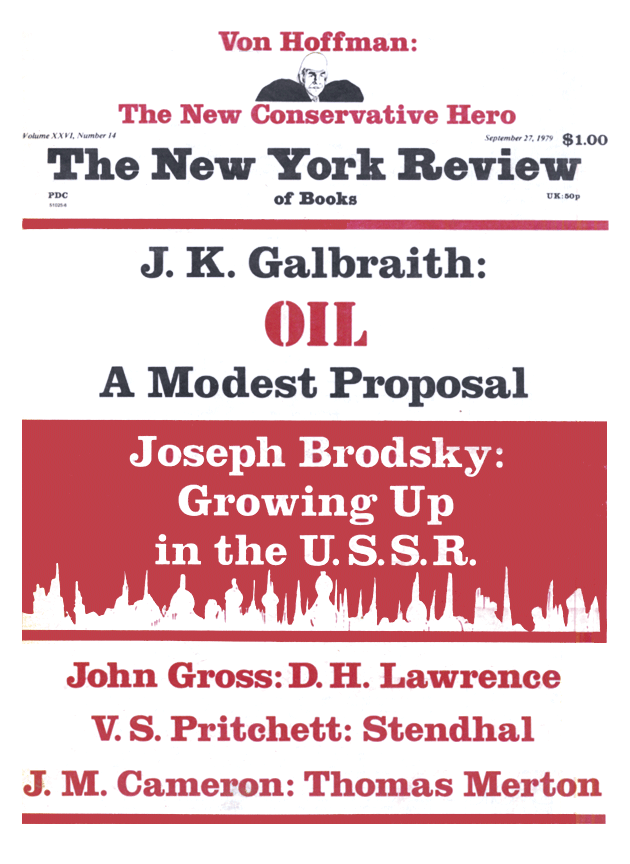In response to:
'A Decade of Permissiveness' from the May 17, 1979 issue
To the Editors:
I would be remiss if I did not respond to John Wheeler’s emotional objections to my new idea of superluminal communication [NYR, May 17]. Although Henry Stapp, in his paper “Are Superluminal Connections Necessary?” (Lawrence Berkeley Laboratory Report No. 5559), does not go as far as I do in maintaining that superluminal information transfer is a technological possibility, he does argue that superluminal information transfer is a necessary consequence of Bohr’s interpretation of quantum theory. Gardner repeats my argument that superluminal transfer without signals* does not violate Einstein’s commandments on relativity. The reason is simple. Felix Klein showed that geometries can be understood in terms of invariance principles (“Erlanger Program”). Einstein’s relativity of space-time depends on local metrical invariance. In contrast, quantum theory depends on a more fundamental, non-local topological invariance which is well known to be free of metrical constraints. Quantum theory is the physics of what is beyond space-time, e.g., the collapse of a black hole to the singularity in which the metrical structure is torn apart.
Wheeler sent me autographed copies of Frontiers of Time, which is his most detailed attempt to prove me wrong. However, I find his argument unconvincing. Wheeler now repudiates his student, Everett, who thought that the quantum wave function was fundamentally real. My theory assumes that the wave function is real, and that all levels of reality, including the mental, form a hierarchy of EPR correlations within correlations. This gives a universal mechanism for the creation of form out of chaos. Everett has shown that the “mighty frame of the world,” the solid classical reality, can be consistently understood in terms of wave function correlations alone. Wheeler no longer supports this theory because he realizes that without the ability to jump between branch worlds of the splitting universe, the Everett thesis rests on a shaky foundation of “metaphysical baggage.” This “paranormal” ability to leap from world to world is simply another way of talking about quantum messages without signals faster-than-light. Wheeler has now retreated to the position that the wave function is not real but is a paper tiger, an artifact of pencil and paper calculation. I am presently writing my own book on this subject. The interested reader should also consult Gary Zukav’s The Dancing Wu Li Masters (William Morrow, 1979), and John Gribbon’s Time Warps (Delacorte, 1978) for highly readable background on my ideas.
A paper written by two physicists working at Wheeler’s institute (Wooters and Zurek, Physical Review D, Vol. 19, January 15, 1979, p. 473) contains what is essentially one-half of my idea for the superluminal communicator whose patent disclosure is mentioned by Gardner. The authors summarize the basis for Wheeler’s antipathy as follows:
The situation described here and the analysis outlined above are essentially the same as in the Einstein-Podolsky-Rosen “paradox.” There too what we choose to measure on one system affects the wave function of another system far away. But the final distribution of measured values of the far away system is again independent of our choice. (pp. 478-479)
If the measured values of the far-away system did depend on our choice here and now, then we could send a quantum message without an energy-transporting signal, faster-than-the-speeding-photon. We could even send a message backwards in time (e.g., Time Warps)! This is more than mere science fiction.
Note that Wooters and Zurek point out that their conclusion is only justified for the “total” or “final” distribution. This distribution is the summation over “partial interference patterns.” These patterns are observable and there is no need to sum them up. The partial patterns fall into two classes, in which (1) the Einstein detector is held fixed, or (2) the Einstein detector is allowed to move. Summing up all the partial patterns of each class separately throws out the superluminal baby with the bathwater. Indeed, Wheeler’s whole case rests on this unneccssary handling of the available data processing alternatives:
The first thing to notice is that these partial interference patterns…cannot all have the shape of the total interference pattern. (p. 476)
Thus, I maintain that it may be possible to build faster-than-light communicators by monitoring variations in the spatio-temporal coherence records from detections of Einstein-Podolsky-Rosen correlated pairs of quanta. Astronomers may now be seeking such a faster-than-light communicator in the sky in the puzzling object “SS433.” Walter Sullivan (The New York Times, April 24, 1979, pp. C.1-2) writes:
The blue shift and red shift variations seem to occur in tandem, as though on opposite sides of a central energy source. Yet they appear to be too far apart for such coordinated behavior.
Carl Sagan’s CETI group should check the coordinated blue shift and red shift “variations” for intelligent messages.
Jack Sarfatti
San Francisco, California
This Issue
September 27, 1979
-
*
Both Wheeler and Stapp get confused on this “signal” issue. ↩


